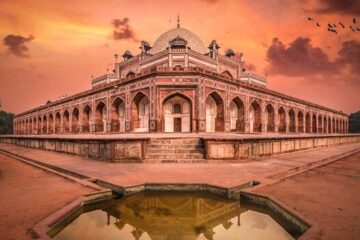Agra Fort
One of the most amazing structures built in India during the Mughal period is the beautiful Agra Fort. The 94-acre building is located on the banks of the Yamuna River, about 3 kilometers from the famous Taj Mahal in Agra city. If you are planning a trip to Agra, then make sure to include this former Mughal house in your itinerary. Additionally, choose hotels in Agra that are conveniently close to the Taj Mahal, Agra Fort, and other major attractions.
Read this blog for some time before planning a trip. Here’s all you need to know about Agra Fort, including its background, features, hours of operation, cost of entry, interesting trivia, and more.
Agra Fort Information
| Location | Agra |
| Timings | Sunrise to sunset; every day |
| Entry | Only through Amar Singh Gate |
| Entry Fee | ₹ 40 (Indians); ₹ 650 (foreigners); free entry for kids below the age of 15 years |
| Still and Video Cameras | Allowed |
| Commissioned by | Emperor Akbar |
| Architectural Style | Mughal style |
| Status | UNESCO World Heritage Site |
| Area | 94 acres |
| Year of Establishment | 1573 |
| Best Time to Visit | October to February |
| Material Used | Red sandstone and marble |
Agra Fort: History
Do you know that this fort in Agra was earlier owned by Chauhan Rajputs as a fort made of bricks? Historians believe that Ibrahim Lodhi shifted to Agra and took up residence in the fort after the First Battle of Panipat in 1526. The first Mughal emperor, Babur, assassinated him after taking control of the fort and constructing a stepwell or stepwell inside.
After capturing the fort, Akbar decided to establish it as his capital. But the fort was crumbling at that time and was losing its glory and splendor. Thus, Akbar rebuilt the fort using bricks for the interior and red sandstone for the façade. The construction of this fort took eight arduous years and was completed in 1573 with the arduous effort of 1,444,000 builders.
Even though Akbar is credited with the construction of Agra Fort, Akbar’s grandson Shah Jahan oversaw its transformation into what it is today. He used white marble to rebuild palaces and mosques after demolishing many structures inside the fort. Shah Jahan’s son Aurangzeb later captured the fort after the Battle of Samogarh in 1658 and he imprisoned his father for eight years until his death.
After the death of Shahjahan, many emperors and kings captured and looted the fort. The British captured Agra Fort during the Second Anglo-Maratha War in 1803 and handed it over to the Government of India after independence.
Agra Fort Architecture
The majestic Agra Fort has Mughal style architecture and is constructed of marble and red sandstone. The fort is surrounded by massive red sandstone double-walled walls that form a semicircle when viewed from above. These walls are 70 feet high and their circumference is about 2 kilometers. Delhi Gate, Amar Singh Gate, Hathi Pol and Ghazneen Gate are the four gates that enter the fort. The largest of these, Delhi Gate, served as Akbar’s official gateway. Only the Amar Singh Gate allows visitors to enter the fort.
There are large halls, majestic mosques, and grand chambers within this fort. The primary buildings and monuments of the fort are the Diwan-i-Aam and Diwan-i-Khas, which are private and public halls; royal pavilions containing mosques; the marble royal bathrooms; Sheesh Mahal, or Mirror Palace; and the courtroom, among other things. It is believed that the fort once contained more than 5,000 buildings and monuments. However, only twelve of these survived the entire period.
Agra Fort: Today
After the Taj Mahal, Agra Fort is one of the most visited tourist attractions in Agra today and one of the top forts in all of India. The fort was designated a UNESCO World Heritage Site in 1983. At Amar Singh Gate, you can buy entry tickets to the fort and rent audio tours from the booth located inside the entrance. The fort is next to Sadar Bazaar, one of the best shopping places in Agra. It is one of the most famous tourist attractions of Agra.
Agra Fort Light and Sound Show
At the fort, the UP government organizes light and musical performances in the evening. The light and sound display of Agra Fort takes you through its rich history. It is one of the main attractions of Agra Fort and is considered to be one of the best light and sound exhibitions in India.
- Timings: 30 minutes after sunset; every day
- Shows: Hindi and English
- Tickets: ₹ 70 for Indians; ₹ 200 for foreigners; ₹ 40 for students
Things to See in Agra Fort
The fort is made up of numerous palaces, halls, and other historical monuments that were constructed at various periods. The following are the main attractions of Agra Fort:
- Jahangir Mahal, the red sandstone palace built for Jahangir by his father Akbar
- Jahangir‘s Hauz, the monolithic tank or bathtub built for Jahangir
- Bengali Mahal, the palace of Akbar which is said to have many secret underground passages
- Khas Mahal, a white palace built by Shah Jahan featuring floral etchings and Jaali-styled windows. The palace is positioned such that it gives you a distance view of the Taj Mahal.
- Anguri Bagh or the Garden of Grapes, a garden built by Shah Jahan in front of Khas Mahal
- Akbari Mahal, the palace where Akbar spent the last years of his life
- Sheesh Mahal, a mirror palace built by Shah Jahan that features tiny glass-mosaic decorations.
- Babur’s Baoli, a Baoli or stepwell. This was the first modification made to the fort by Babur.
- Shahjahani Mahal, a white marble palace featuring an octagonal tower, side rooms, and a large hall
- Musamman Burj, an octagonal building with a clear view of the Taj Mahal. This is the place where Aurangzeb imprisoned his father, Shah Jahan, who spent 8 years of his life watching his wife’s memorial from a distance.
- Nagina Masjid, a mosque built for the ladies. It is said that below the mosque was the Mina Bazaar, where the epic romance between Jahangir and Nurjahan blossomed.
- Macchi Bhavan, a large terrace with hallways that connect to various chambers of the fort
- Ghaznin Gate, a gate that originally belonged to the Tomb of Muhmud of Ghazni and was brought to the fort during the rule of British
- Diwan-i-Khas, the hall of private audience, has tall, arched doorways made of white marble. The renowned Peacock Throne of Shah Jahan with the famous Kohinoor diamond used to be kept here before it was shifted to Delhi.
- Diwan-i-Am, the hall for public audience built by Shah Jahan
- Moti Masjid aka the Pearl Masjid, is a mosque which is currently not accessible to the public. The private shrine of Shah Jahan, namely Mina Masjid, is situated close to the Moti Masjid.
Lesser-known facts about Agra Fort
- India Post released a commemorative stamp in 2004 to celebrate the Aga Khan Award for Architecture, which the Agra Fort had earned.
Sir Arthur Conan Doyle’s Sherlock Holmes mystery book, The Sign of the Four, mentions the Agra Fort.
Shah Jahan chose to create the Red Fort in 1638 after deciding to relocate from Agra to Delhi, drawing inspiration from the Agra Fort.
Lotus Temple, Delhi: Location, Facts, History, and Architecture



1 Comment
The Taj Mahal in Agra: Details, Background, Hours, and Entrance · May 25, 2024 at 5:12 pm
[…] Agra Fort (3.1 km) […]